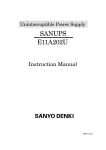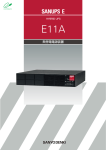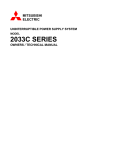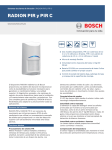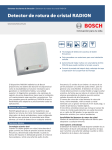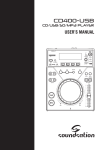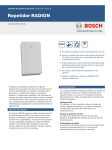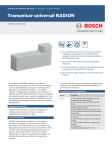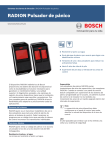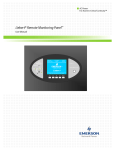Download Sanyo SANUPS E11A102A User's Manual
Transcript
Uninterruptible Power Supply SANUPS E11A102A Instruction Manual M0007084E Introduction Thank you for choosing the SANUPS (E11A102A). SAVE THESE INSTRUCTIONS This manual contains important instructions for E11A102U001 that should be followed during installation and maintenance of the UPS and batteries.To use the UPS correctly and safely, read this manual before using the UPS. After reading, please keep it handy for convenient reference. This UPS is intended for installation in a temperature-controlled indoor environment free of conductive contaminants. ・ Operating temperature: 0 to 40゚C (32 to 104゚F) UPS is an abbreviation for Uninterruptible Power Supply. Table of contents 1. Safety Precautions -----------------------------------------------------------------------------------------------------------------------1 2. For Proper Operation -------------------------------------------------------------------------------------------------------------------6 2.1 2.2 2.3 2.4 Input Power Requirements-----------------------------------------------------------------------------------------6 Installation Precautions ---------------------------------------------------------------------------------------------6 Usage Precautions-----------------------------------------------------------------------------------------------------6 Dealing with Errors --------------------------------------------------------------------------------------------------7 3. Checking the Contents of the Package------------------------------------------------------------------------------------------7 4. Overview -------------------------------------------------------------------------------------------------------------------------------------8 5. External Dimensions and Part Names ------------------------------------------------------------------------------------------9 5.1 Front and Back Panels----------------------------------------------------------------------------------------------9 5.2 Control Panel and Indicators ----------------------------------------------------------------------------------- 10 5.3 External Interfaces-------------------------------------------------------------------------------------------------- 11 6. Installation -------------------------------------------------------------------------------------------------------------------------------- 12 6.1 6.2 6.3 6.4 6.5 6.6 6.7 Environment----------------------------------------------------------------------------------------------------------- 12 Transporting ----------------------------------------------------------------------------------------------------------- 12 Installation Space --------------------------------------------------------------------------------------------------- 12 Preparation Before Installation--------------------------------------------------------------------------------- 13 Attaching the Stand ------------------------------------------------------------------------------------------------ 14 Mounting a Rack Mount Type UPS -------------------------------------------------------------------------- 15 Inserting the Bushings -------------------------------------------------------------------------------------------- 15 7. Wiring--------------------------------------------------------------------------------------------------------------------------------------- 16 7.1 UPS Wiring------------------------------------------------------------------------------------------------------------ 16 7.2 External Interface Connections--------------------------------------------------------------------------------- 17 8. Preparations Before Operation ---------------------------------------------------------------------------------------------------- 18 9. Operating Procedures ----------------------------------------------------------------------------------------------------------------- 19 9.1 9.2 9.3 9.4 9.5 UPS Startup (Normal Operation) ----------------------------------------------------------------------------- 19 UPS Startup (Battery Power)----------------------------------------------------------------------------------- 20 Outage Simulation Test ------------------------------------------------------------------------------------------- 21 UPS Shutdown (Daily) -------------------------------------------------------------------------------------------- 22 UPS Shutdown (If Not to Be Used for More Than a Week) --------------------------------------- 22 10. User Settings --------------------------------------------------------------------------------------------------------------------------- 23 10.1 Setup Menu Item List ------------------------------------------------------------------------------------------- 23 10.2 Setup Menu Operations ----------------------------------------------------------------------------------------- 24 11. Maintenance and Inspection------------------------------------------------------------------------------------------------------ 25 11.1 11.2 11.3 11.4 11.5 11.6 11.7 Daily Inspection ---------------------------------------------------------------------------------------------------- 25 Periodic Inspection------------------------------------------------------------------------------------------------- 25 Parts Replacement------------------------------------------------------------------------------------------------- 25 Battery Maintenance---------------------------------------------------------------------------------------------- 26 Battery Test---------------------------------------------------------------------------------------------------------- 27 Battery Exchange -------------------------------------------------------------------------------------------------- 28 Bypass Fuse Exchange------------------------------------------------------------------------------------------- 30 12. Troubleshooting ------------------------------------------------------------------------------------------------------------------------ 31 13. Alarm Sounds -------------------------------------------------------------------------------------------------------------------------- 33 14. Maintenance Bypass Power Supply (Option) ------------------------------------------------------------------------------ 34 15. Functional Description -------------------------------------------------------------------------------------------------------------- 35 15.1 15.2 15.3 15.4 Basic Operation----------------------------------------------------------------------------------------------------- 35 Protective Functions ---------------------------------------------------------------------------------------------- 37 Protective Function Table--------------------------------------------------------------------------------------- 38 Specifications -------------------------------------------------------------------------------------------------------- 39 16. Warranty --------------------------------------------------------------------------------------------------------------------------------- 40 Appendix Usage notes for SANUPS SOFTWARE STANDALONE ------------------------------------------- 41 1. Safety Precautions PRECAUTIONS (IMPORTANT SAFETY INSTRUCTIONS) Before installing, operating, performing maintenance or inspecting the UPS, be sure to read this manual and accompanying documents carefully to obtain a clear understanding of the information related to its operation, safety and important precautions. This manual described two warning levels, DANGER and CAUTION, as described below. ! DANGER ! CAUTION :Denotes immediate hazards which WILL probably cause severe bodily injury or death, as a result incorrect operation. :Denotes hazards which COULD cause bodily injury and product or property damage, as a result incorrect operation. Additionally, even those hazards denoted by ! CAUTION △ could lead to a serious accident, so the instructions should be strictly followed. The following labels indicate particularly important instructions which must be carefully followed. The graphic symbols indicate prohibited and mandatory actions : Indicates actions that must not be allowed to occur (prohibited actions). : Indicates actions that must be taken (mandatory actions). − 1 − 1. Installation Precautions ! CAUTION • • • • • The UPS should be installed only by technically qualified personnel. Improper installation can result in electric shock, bodily injury, and/or fire. Never operate or store the UPS in the following environmental conditions. Doing so may cause the UPS to malfunction, sustain damage or deteriorate, which could result in a fire. a. In ambient environmental conditions other than those specified in the product brochure and instruction manual (temperature 0 to 40°C (32 to 104゚F), relative humidity 20 to 90%), such as in extremely high or low temperature and high humidity. b. Where the UPS is exposed to direct sunlight. c. Where the UPS is directly exposed to the heat from a heat source, such as a stove. d. Where the UPS may be subject to vibration or physical shock. e. Near a device that may emit sparks. f. In the presence of dust, salt or corrosive or flammable gas. g. Outdoors If you mount the UPS in a rack, mount it in a rack that can be well ventilated, and be careful not to block the air intake and exhaust vents of the rack and UPS. Do not allow the air intake or exhaust vents to be obstructed. Keep the front and back of the UPS at least 20 cm away from the wall. If the air intake or exhaust vent is blocked, the internal temperature of the UPS rises, which could cause battery deterioration resulting in a fire. For maintenance, the UPS requires at least 1 m (39.4in) space at the front. The space around the UPS and the rack must be ventilated. Unless the specified ventilation airflow (5 m3/h) is maintained, gas produced by battery charging could result in rupture or explosion of the case. Install the UPS on a stable surface capable of bearing the weight (16kg, 35.27 lbs) of the UPS in the correct manner specified in this manual. If the UPS is installed incorrectly, impact or vibration could cause it to fall or move inadvertently, resulting in bodily injury. Be careful to avoid back strain. 2. Wiring Precautions ! CAUTION • • • • • Wiring should be performed only by technically qualified personnel. Incorrect wiring can result in electric shock and/or fire. Protection in primary circuits against over currents, short circuits and earth faults is not provided inside this UPS. Protection in primary circuit against over currents short circuits and earth faults shall be providied as part of the building installation. Connect the grounding cable securely in the manner specified. Failure to connect the grounding cable may result in electric shock. The grounding cables of all load devices* connected to the output of the UPS must be securely connected to the grounding terminal. Failure to connect the grounding cables correctly may result in electric shock The socket-outlet shall be installed near the equipment and shall be easily accessible. * Load devices are devices such as computers that are connected to the UPS. − 2 − 3. Operating Precautions ! DANGER • • Immediately shut the UPS off if it malfunctions, or if an unusual odor or noise is observed. Failure to do so may result in a fire. To avoid electric shock, do not open the cover of the UPS. ! CAUTION • • • • Risk of electric shock, do not remove cover, No user serviceable part inside. Refer serviving to qualified personnel. The space around the UPS must be well ventilated. Otherwise, gas produced by battery charging could result in rupture or explosion of the case. Before starting the UPS, make sure that the load side is safe. Be sure to refer to the instruction manual while operating the UPS. The operating state of the UPS, as determined by the INV. ON/STAND BY switch and the MAIN switch, is indicated by the LEDs as shown the table below. The following table shows the UPS states resulting from operation of the MAIN SW and INV ON/STAND BY switches. Check the indicators before and after operating. Do not touch the MAIN SW and INV ON/STAND BY switches unless necessary. If power is supplied incorrectly, an electric shock or bodily injury could result. UPS Status MAIN SW OFF ON OFF ON • • • INV ON/STAND BY STAND BY STAND BY ON ON Power Output Status LEDs OUTPUT Stopped Stopped INPUT (off-green), INPUT (on-green), Power supplied from inverter INPUT (blinking-green), Power supplied from inverter INPUT (on-green), OUTPUT (off-green) OUTPUT (off-green) OUTPUT (on-green) OUTPUT (on-green) Avoid inserting sharp objects or fingers into the fan. Doing so may result in bodily injury. Do not touch the UPS, including the cables, if you hear thunder nearby. There is danger of electric shock from a lightning strike. Do not detach the cover of the options, except when you use some options. There is danger of electric shock and equipment damage. PROHIBITED • • • • • Never use the UPS for the following types of loads: a. Medical instruments used for life support. b. Control units for trains or elevators, failure of which could cause bodily injury. c. Computer systems upon which social or public infrastructure depends. d. Devices which serve applications related to the above. Contact your sales representative if you need to use the UPS in an application like the above. Special equipment, such as redundant devices or an emergency generator must be incorporated when operating, maintaining and controlling systems in which a UPS is used with loads affecting life-support or public infrastructure-dependent applications. Do not smoke or use an open flame near the UPS, as it could cause the UPS to explode or rupture, resulting in injury or fire. Do not place containers of liquid, such as a flower vase, on the UPS. If the container was to spill, the liquid could cause a short circuit, resulting in sparks or fire inside the UPS. Do not sit, step or lean on the UPS, as bodily injury could result if the UPS was to fall. Repairs and modifications to the UPS prohibited All repairs and modifications to the UPS are prohibited. The UPS contains high voltage and no user serviceable parts. Opening the cover, exchanging the battery, parts exchange, and repair can result in electric shock and damage to the UPS when performed by anyone other than qualified service personnel. All such repairs and modifications will void the warranty. − 3 − 4. Radio Frequency Interference ! • CAUTION This equipment has been tested and found to comply with the limits for a Class A digital device, pursuant to part 15 of the FCC Rules. These limits are designed to provide reasonable protection against harmful interference when the equipment is operated in a commercial environment. This equipment generates, uses, and can radiate radio frequency energy and. if not installed and used in accordance with the instruction manual, may cause harmful interference to radio communications. Operation of this equipment in the residential area is likely to cause harmful interference in which case the user will be required to correct the interference at his own expense. 5. Maintenance and Inspection Precautions ! CAUTION • • • • • • Maintenance and repair of the inside of the UPS should be performed only by technically qualified personnel. Electric shock, bodily injury and burns, fuming, or fire could otherwise result. Contact your nearest sales representative or authorized service center to have the UPS checked out or to replace defective parts. Opening the cover carelessly can result in an electric shock or burn. Replace the batteries periodically (once every 4.5 years when operated at 25°C (77゚F)). Using batteries after their service life has expired may cause a fire. Never use organic chemicals such as gasoline, thinner, benzene or detergent to clean batteries. These can cause the casing to crack and leak, resulting in fire. Do not allow sharp metallic objects or fingers to touch the battery connectors of the UPS. Doing so may result in an electric shock. Do not touch any parts inside the UPS, even when AC input is removed. Voltage produced from the batteries can still cause an electric shock. 6. Relocation and Transportation Precautions ! CAUTION • • • Be careful to avoid falling or dropping the UPS during relocation or transportation, as bodily injury could result. Be careful to avoid back strain when handling the UPS. To avoid bodily injury caused by dropping the UPS, do not tilt it more than 10 degrees to either side when moving it. Take preventative measures to avoid dropping the UPS if it must be tilted more than 10 degrees when moving it. − 4 − 7. Battery Handling Precautions ! CAUTION • • • • • • • • • • • • Risk of explosion if battery is replaced by an incorrect type Dispose of used batteries according to the instructions. Battery servicing should be performed by technically qualified personnel. Keep unqualified personnel away from batteries. Replace batteries only with the same model and brand: HRL1234WF2FR manufactured by CSB BATTERY Co., LTD. Customers should not dispose of used batteries themselves. Contact your nearest sales representative, authorized service center or sales office to dispose of used batteries. Do not use batteries after their service life has expired. Doing so may result in fuming or fire. Additionally, the battery backup function may fail to operate with such batteries, so that power will not supplied to the load when a power outage occurs. Batteries pose hazards for electrical shock and dangerous short-circuit current. The following precautions should be observed when working with batteries: a. Remove watches, rings and other metal objects. b. Use insulated tools. c. Wear rubber gloves and boots. d. Do not lay tools or metal parts on top of batteries. e. Disconnect the charging source prior to connecting or disconnecting battery terminals. f. Determine whether the batteries have been inadvertently grounded, and if so, remove the source of grounding. Contact with any part of a grounded battery can result in electric shock. Do not attempt to open or disassemble batteries. The electrolyte is harmful to the skin and eyes. The battery contains diluted sulfuric acid, which is extremely toxic. If a battery leaks, take appropriate measures to prevent any battery fluid contacting your skin or clothing. Diluted sulfuric acid may cause blindness if it gets into the eye, may burn skin upon contact. It is electrically conductive and corrosive. Observe the following procedures if electrolyte spills: a. Wear full eye protection and protective clothing. b. If sulfuric acid contacts the skin, wash it off immediately with water. c. If sulfuric acid contacts the eyes, flush thoroughly and immediately with water, and seek medical attention. d. Spilled sulfuric acid should be washed down with a suitable acid-neutralizing agent, such as a solution of approximately one pound (500 grams) bicarbonate of soda in one gallon (4 liters) of water. The bicarbonate of soda solution should be applied until evidence of reaction (foaming) has ceased. The resulting liquid should be flushed with water and the area dried. Lead acid batteries can present a risk of fire due to generation of hydrogen gas. The following procedures should always be followed: a. DO NOT SMOKE when near batteries. b. DO NOT allow flames or sparks near batteries. c. Before working with batteries, discharge static electricity from the body by first touching a grounded metal surface before touching the batteries. Do not dispose of batteries in fire, as they could explode. If a fire occurs near a battery, do not use water to extinguish it. Use only a powder-distinguishing agent (ABC). Using water can cause the fire to spread. Strictly observe the following precautions when handling the batteries. Failure to do so may cause battery leakage, overheating or explosion. a. Do not solder to any part of the battery directly. b. Do not charge the battery with reversed positive (+) and negative (-) terminal polarity. c. Do not mix different battery types, brands or versions. d. Do not attempt to peel off or break the outer covering of a battery. e. Do not subject batteries to strong physical shock, or throw them away. f. Clean batteries with water-moistened cloth squeezed hard. Do not use organic compounds such as gasoline, thinner, benzene or detergent. g. Electrical energy may remain in a battery even after its service life has expired. Do not allows sparks near used batteries, and protect them from short-circuiting. − 5 − 2. For Proper Operation 2.1 Input Power Requirements (1) Make certain that the AC input voltage and frequency correspond to the specified equipment rating (100V, 110V, 115V, 120V, within -20% and +15%, and 50 or 60 Hz ±5%: Active Filter and Economy Mode*). * The frequency variation range is set to ±3% when the UPS is shipped from the factory. If the frequency variation range of input power supply is ±5%, select ±5% as described in item ③ “Frequency sync range” of 10.1 “Setup Menu Item List”. Because the frequency sync range is the same for both input and output, an input frequency error occurs when the frequency sync range exceeds the setting value, preventing the UPS from switching to active filter mode or economy mode operation. (2) The current capacity of the AC power supply must satisfy the requirements of the UPS (0.96 kVA or more). (Breaker capacity of 20 A or more is recommended.) 2.2 Installation Precautions (1) Carefully consider the leakage current when a leakage circuit breaker is installed on the input side. The maximum leakage current of the UPS is 3mA. (2) Keep the UPS at least 1 m (about 40 inches) away from CRT displays. Other devices which may be sensitive to magnetic flux should be kept away from the UPS, as it emits a slight amount of magnetic flux. (3) The UPS employs a fan for forced-air cooling. Provide at least 20 cm (about 8 inches) clearance at the front and back of the UPS to permit free airflow at the air intake and exhaust vents. Also, for maintenance purposes, a space of at least 1 m (about 40 inches) will be needed at the front of the UPS and a space of at least 50 cm (about 20 inches) will be needed at the back of the UPS. When mounting the UPS in a rack, use a rack which allows ventilation and provide at least 20 cm (about 8 inches) clearance from the front and back of the rack to permit free airflow at the air intake and exhaust vents. Also, for maintenance purposes, a space of at least 1 m (about 40 inches) will be needed at the front of the rack, and a space of at least 50 cm (about 20 inches) will be needed at the back of the rack. For details, see §6.3 “Installation Space”. (4) When the AC input power is single-wire grounded, always connect the ground phase to the S terminal (phase) side on the UPS. (5) As far as possible, do not ground the output (load) side. If you must make a single-wire grounded connection, always connect the ground phase to the V terminal (phase) side on the UPS. (This is to prevent short-circuiting by the ground.) 2.3 Usage Precautions (1) Never short-circuit the output terminals, or connect a load which draws short-circuit current. Doing so causes protective functions to activate or fuses to open, preventing output. (2) Unsuitable load devices Do not connect laser printers, plain paper fax machines, copy machines, or overhead projectors as load devices. Such devices typically include heating elements that draw high current. This may cause an overload that could prevent battery backup operation when an outage occurs, and could damage the UPS. (3) Power supply environment If the UPS is used in an environment subject to long and frequent power outages (more than once a week), the batteries may not receive sufficient charge, which could result in foreshortened battery life and premature battery failure. (4) If the UPS is not operated for a long period, the batteries may require recharging. Operate the UPS with no load to recharge the batteries as indicated in the following table, according to the storage temperature. If the batteries in the UPS are left uncharged, their service life will be greatly foreshortened. Storage Temperature 25°C (77°F) 30°C (86°F) 40°C (104°F) Charge Interval Once every 6 months Once every 4 months Once every 2 months − 6 − No-Load Operation At least 20 hours At least 20 hours At least 20 hours (5) Insulation testing Before testing indoor wiring insulation, shut down the UPS and disconnect the input and output cables. Conducting an insulation test with the UPS connected may damage electronic components such as the built-in arrester. (6) Rack support rails (not supplied) are required to mount the UPS on a rack. For details, contact your supplier or Sanyo Denki representative. 2.4 Dealing with Errors Contact your supplier or Sanyo Denki representative if any of the following occur. (1) The red ALARM indicator lights (except when the UPS stops because of a prolonged power outage). (2) The green INV.ON/STAND BY indicator, green INPUT indicator, or green OUTPUT indicator does not light even when the UPS is operated properly. (3) Another condition occurs which you suspect is caused by a failure in the UPS. 3. Checking the Contents of the Package After opening the package carton, check to be sure that it contains all of the following items. If any item is missing, contact your supplier or Sanyo Denki representative. (1) UPS (2) Accessories Instruction Manual (this manual) Fuse 15 A Network cable Rack mounting bracket (Right) Rack mounting bracket (Left) Screws for Rack mounting brackets Bushings Stands Screws for Stands Power Management Software disc (CD-ROM) (SANUPS SOFTWARE STANDALONE) 1 1 1 1 1 1 4 6 2 4 1 including Install Guide and User guide * Note about sale or transfer of ownership If you sell the UPS or transfer ownership to a third party, all accessories and other items supplied with the UPS must be sold or transferred together with the UPS. − 7 − 4. Overview The SANUPS E11A is a stationary-type uninterruptible power supply designed to provide high-quality, stable AC power to critical equipment that requires continuous, uninterrupted power. The UPS is comprised of rectifier, charger, inverter, battery, and utility power transfer (bypass) circuits. In the event of failure of the AC utility power source, AC output to the load is sustained by the inverter converting DC power from the batteries. When the utility power recovers, inverter operation continues while the batteries are recharged. The UPS is therefore able to supply completely uninterrupted AC power to connected loads without even momentary power loss. B ypass Fu se Bypass C ircuit Filter M AIN SW Filter AC In pu t F u se Rectifier AC O utpu t Inverter Charger D C /D C Con verter CARD I/F PC I/F C on trol Circu it F u se < Batteries LA N I / F (option) UPS Block Diagram − 8 − Extern al Batteries 5. External Dimensions and Part Names 5.1 Front and Back Panels ③ 440 17.32 ② (Inside cover) 86 3.39 (Inside cover) ① ⑤ ⑦ ⑨ MAIN SW EXT. BATT ⑥ ④ ⑫ ⑧ ⑩ ⑪ Length: 1.8 m (70.9 inch) Depth: 408 mm (16.06 inch) Weight: 16 kg (35.27 lbs) No. Name ① Control panel and indicators ② ③ ④ ⑤ ⑥ ⑦ ⑧ ⑨ ⑩ ⑪ ⑫ Forced bypass switch Battery connector Card interface PC interface Exhaust vent Option card slot Input switch Bypass fuse Output terminals Input power plug External battery connector Label Function Control panel for control operations, UPS status - display, and function settings Forced Bypass Switch to bypass UPS during maintenance - Battery connector CARD I/F Connector for external signal transfer PC I/F Connector for external PC-WS signal transfer - Ventilation OPTION CARD Option card slot MAIN SW Input power On and Off switch BYPASS FUSE Fuse to protect bypass circuits OUTPUT Normal power output terminals INPUT Input power plug EXT.BATT Connector for external battery − 9 − 5.2 Control Panel and Indicators LED11 LED5 LED6 LED10 LED7 LED8 ① LED12 LED4 ② LED9 LED0 No. LED2 LED3 LED4 LED5 LED6 LED7 LED8 LED9 LED10 ① LED11 ② ③ LED3 Functions Status display Lit Not lit Input power status Normal input - UPS output power status Inverter operation OFF Economy mode OFF (*3) ECONOMY Operation mode operation (*1) Double conversion DOUBLE Operation mode OFF (*3) mode operation (*2) CONVERSION Battery power BATT.LOW Battery status Battery power low normal Load level 25% Load 25% or more Load under 25% Output voltage setting 25 Setting other than - 100V (*4) 100V 50 75 100 Load level 50% Output voltage setting 110V (*4) Load level 75% Output voltage setting 115V (*4) Load level 100% Output voltage setting 120V (*4) Overload display Alarm display Load 50% or more Load under 50% Setting other than - 110V Load 75% or more Load under 75% Setting other than - 115V Load 100% or more Load under 100% Setting other than - 120V Load 105% or more Load under 105% Failure detected No failure O.L. ALARM INV.ON Inverter operation On/Off operation STAND BY INV.ON Inverter operation status Inverter operation STAND BY Off Slow blink Input error Bypass operation - - Battery exhausted - 100V setting - 110V setting - 115V setting - 120V setting - - Bypass operation Fast blink - - - - - - - - - - - - - - - - BATT.TEST Battery test LED12 BATT.TEST Battery test ③ LED2 INPUT OUTPUT LOADLEVEL(%) LED0 LED1 Label LED1 CLEAR Result: Normal - Result: Error Status: Testing Stop buzzer, clear result of battery test ※1. Economy mode operation・・・・When power conditions are good, UPS supplies this power to the load. ※2. Double conversion mode operation・・・・When power conditions fluctuate, UPS converts to the stable power, and supplies to the load. ※3. Active Filter Mode operation・・・・When load power fluctuates. Suppresses high frequencies generated by the load and improves power factor. When the green DOUBLE CONVERSION and the green ECONOMY are both off, the UPS is in Active Filter Mode. ※4. The output voltage setting is displayed for about 5 seconds after the UPS is powered on (LED initialization display). This manual uses a frame to indicate switches. (Example: INV.ON/STAND BY ). It also describes the color of the LED whenever it refers to an indicator on the control panel. (Examples: Green INV.ON/STAND BY, red ALARM) : Indicates a lit LED In the illustrations in this manual : Indicates a blinking LED − 10 − 5.3 External Interfaces ① UPS back panel MAIN SW EXT. BATT ② No. Name ① PC I/F (PC interface) (RS-232C) Function Allows you to control the UPS from a computer (PC or workstation) by using the supplied power management software. Install the power management software (*2) on the computer, and connect the computer to the UPS with the supplied network cable. Interface mode (*1): Workstation mode (*1): Use the controls on the front panel to set the interface mode. For more information, see item ⑤ PC Interface mode in §10.1 “Setup Menu Item List”. D-sub9-pin (male) 2 RXD 3 TXD 5 GND 4 DTR 6 DSR 8 CTS 7 RTS ① ② ③ ④ ⑤ ⑥ ⑦ ⑧ ⑨ Fixing screw inch (*2): For more information, refer to the User Guide in the CD-ROM of the SANUPS SOFTWARE. Allows you to connect an optional Sanyo LAN interface card. ② CARD I/F (Card interface) Interface mode (*1): Workstation mode Note This connector is for use with Sanyo option cards only. Cannotbe used with other than Sanyo option cards. 5 (COM) 1 7V,1A/Option power D-sub 9-pin (female) ⑨ ⑧ ⑦ ⑥ ⑤ ④ ③ ② ① 2 RXD (in) 3 TXD (out) Note The CARD I/F and PC I/F connectors cannot be used at the same time. − 11 − Fixing screw inch 6. Installation ! CAUTION ・ When installing the UPS, carefully follow the instructions in this Instruction Manual. ・ Install the UPS on a stable surface that can bear the weight (16 kg, 35.27 lbs). This surface should be flat, so the UPS cannot fall and cause bodily injury. ・ The possibility of vibration and shock should be minimized at the installation location. ・ All work that involves lifting the UPS, such as mounting it in a rack or attaching the stand, should be carried out by at least 2 persons. ・ Be careful to avoid straining your lower back when mov














































